Analysing Role of Leadership Models in Future Health Profession
VerifiedAdded on 2022/11/18
|12
|3042
|451
Report
AI Summary
This report delves into the analysis of leadership models within the context of future health professions. It begins with a personal story illustrating effective leadership in a healthcare setting, followed by a critical analysis of the leadership qualities displayed, highlighting transformational and transactional styles. The report then explores three key leadership models: the SCARF Model, Belbin Team Roles, and Covey’s 7 Habits of Highly Effective People, discussing their relevance and application in healthcare. It examines how these models can be utilized to enhance leadership skills and improve practices for future health professionals. The report concludes by evaluating the three models in relation to the personal story, providing a comprehensive understanding of leadership in healthcare.
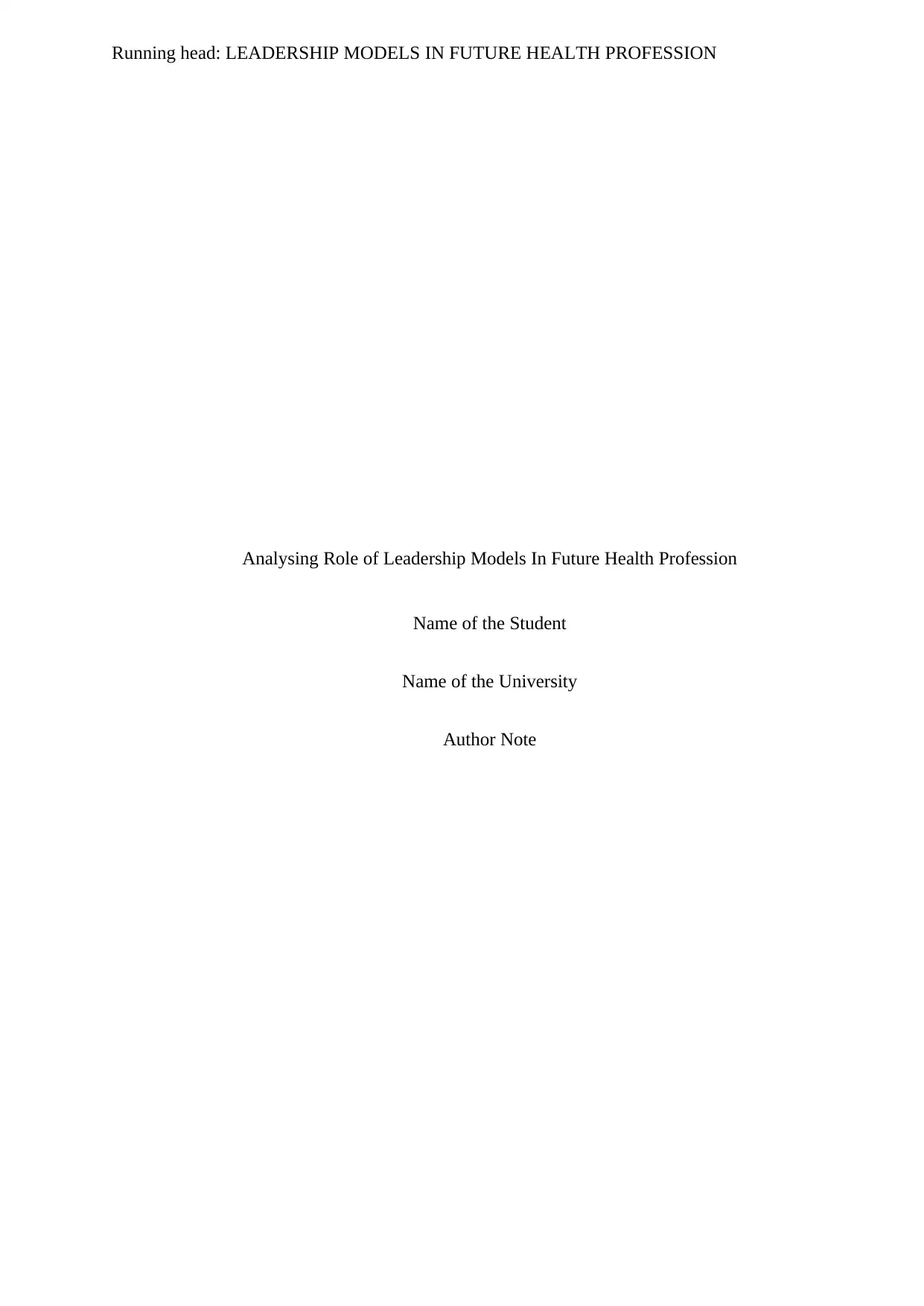
Running head: LEADERSHIP MODELS IN FUTURE HEALTH PROFESSION
Analysing Role of Leadership Models In Future Health Profession
Name of the Student
Name of the University
Author Note
Analysing Role of Leadership Models In Future Health Profession
Name of the Student
Name of the University
Author Note
Paraphrase This Document
Need a fresh take? Get an instant paraphrase of this document with our AI Paraphraser
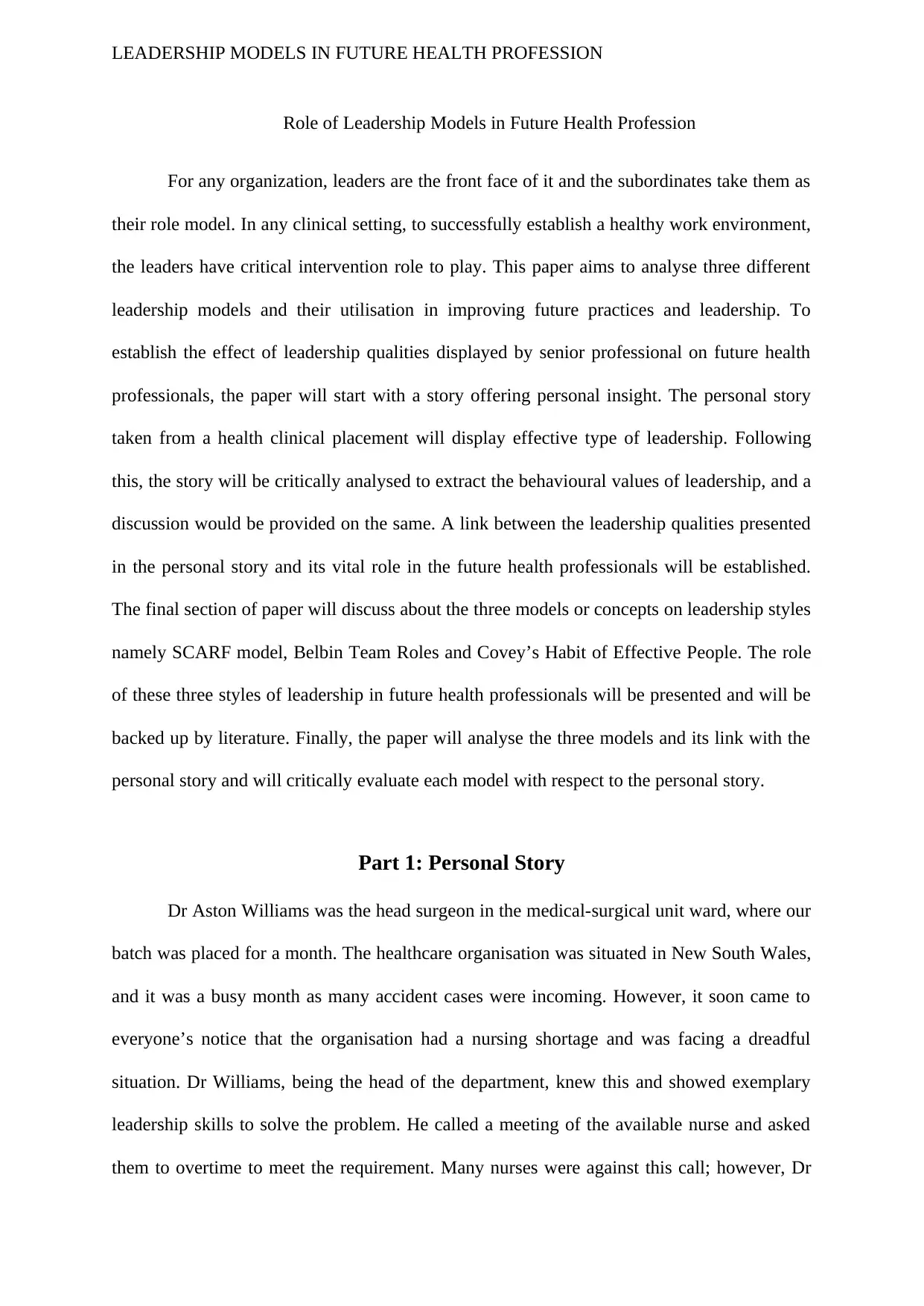
LEADERSHIP MODELS IN FUTURE HEALTH PROFESSION
Role of Leadership Models in Future Health Profession
For any organization, leaders are the front face of it and the subordinates take them as
their role model. In any clinical setting, to successfully establish a healthy work environment,
the leaders have critical intervention role to play. This paper aims to analyse three different
leadership models and their utilisation in improving future practices and leadership. To
establish the effect of leadership qualities displayed by senior professional on future health
professionals, the paper will start with a story offering personal insight. The personal story
taken from a health clinical placement will display effective type of leadership. Following
this, the story will be critically analysed to extract the behavioural values of leadership, and a
discussion would be provided on the same. A link between the leadership qualities presented
in the personal story and its vital role in the future health professionals will be established.
The final section of paper will discuss about the three models or concepts on leadership styles
namely SCARF model, Belbin Team Roles and Covey’s Habit of Effective People. The role
of these three styles of leadership in future health professionals will be presented and will be
backed up by literature. Finally, the paper will analyse the three models and its link with the
personal story and will critically evaluate each model with respect to the personal story.
Part 1: Personal Story
Dr Aston Williams was the head surgeon in the medical-surgical unit ward, where our
batch was placed for a month. The healthcare organisation was situated in New South Wales,
and it was a busy month as many accident cases were incoming. However, it soon came to
everyone’s notice that the organisation had a nursing shortage and was facing a dreadful
situation. Dr Williams, being the head of the department, knew this and showed exemplary
leadership skills to solve the problem. He called a meeting of the available nurse and asked
them to overtime to meet the requirement. Many nurses were against this call; however, Dr
Role of Leadership Models in Future Health Profession
For any organization, leaders are the front face of it and the subordinates take them as
their role model. In any clinical setting, to successfully establish a healthy work environment,
the leaders have critical intervention role to play. This paper aims to analyse three different
leadership models and their utilisation in improving future practices and leadership. To
establish the effect of leadership qualities displayed by senior professional on future health
professionals, the paper will start with a story offering personal insight. The personal story
taken from a health clinical placement will display effective type of leadership. Following
this, the story will be critically analysed to extract the behavioural values of leadership, and a
discussion would be provided on the same. A link between the leadership qualities presented
in the personal story and its vital role in the future health professionals will be established.
The final section of paper will discuss about the three models or concepts on leadership styles
namely SCARF model, Belbin Team Roles and Covey’s Habit of Effective People. The role
of these three styles of leadership in future health professionals will be presented and will be
backed up by literature. Finally, the paper will analyse the three models and its link with the
personal story and will critically evaluate each model with respect to the personal story.
Part 1: Personal Story
Dr Aston Williams was the head surgeon in the medical-surgical unit ward, where our
batch was placed for a month. The healthcare organisation was situated in New South Wales,
and it was a busy month as many accident cases were incoming. However, it soon came to
everyone’s notice that the organisation had a nursing shortage and was facing a dreadful
situation. Dr Williams, being the head of the department, knew this and showed exemplary
leadership skills to solve the problem. He called a meeting of the available nurse and asked
them to overtime to meet the requirement. Many nurses were against this call; however, Dr
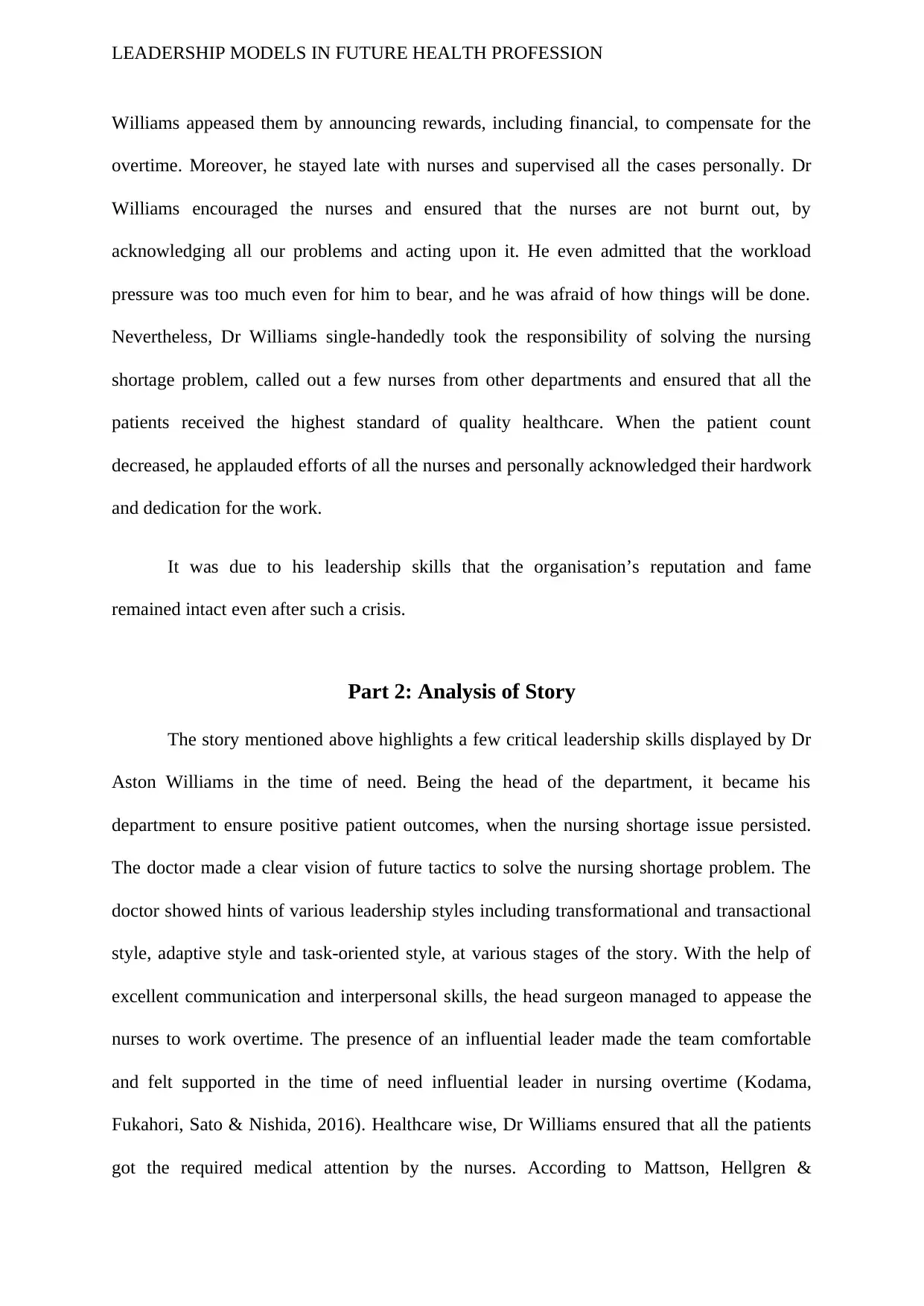
LEADERSHIP MODELS IN FUTURE HEALTH PROFESSION
Williams appeased them by announcing rewards, including financial, to compensate for the
overtime. Moreover, he stayed late with nurses and supervised all the cases personally. Dr
Williams encouraged the nurses and ensured that the nurses are not burnt out, by
acknowledging all our problems and acting upon it. He even admitted that the workload
pressure was too much even for him to bear, and he was afraid of how things will be done.
Nevertheless, Dr Williams single-handedly took the responsibility of solving the nursing
shortage problem, called out a few nurses from other departments and ensured that all the
patients received the highest standard of quality healthcare. When the patient count
decreased, he applauded efforts of all the nurses and personally acknowledged their hardwork
and dedication for the work.
It was due to his leadership skills that the organisation’s reputation and fame
remained intact even after such a crisis.
Part 2: Analysis of Story
The story mentioned above highlights a few critical leadership skills displayed by Dr
Aston Williams in the time of need. Being the head of the department, it became his
department to ensure positive patient outcomes, when the nursing shortage issue persisted.
The doctor made a clear vision of future tactics to solve the nursing shortage problem. The
doctor showed hints of various leadership styles including transformational and transactional
style, adaptive style and task-oriented style, at various stages of the story. With the help of
excellent communication and interpersonal skills, the head surgeon managed to appease the
nurses to work overtime. The presence of an influential leader made the team comfortable
and felt supported in the time of need influential leader in nursing overtime (Kodama,
Fukahori, Sato & Nishida, 2016). Healthcare wise, Dr Williams ensured that all the patients
got the required medical attention by the nurses. According to Mattson, Hellgren &
Williams appeased them by announcing rewards, including financial, to compensate for the
overtime. Moreover, he stayed late with nurses and supervised all the cases personally. Dr
Williams encouraged the nurses and ensured that the nurses are not burnt out, by
acknowledging all our problems and acting upon it. He even admitted that the workload
pressure was too much even for him to bear, and he was afraid of how things will be done.
Nevertheless, Dr Williams single-handedly took the responsibility of solving the nursing
shortage problem, called out a few nurses from other departments and ensured that all the
patients received the highest standard of quality healthcare. When the patient count
decreased, he applauded efforts of all the nurses and personally acknowledged their hardwork
and dedication for the work.
It was due to his leadership skills that the organisation’s reputation and fame
remained intact even after such a crisis.
Part 2: Analysis of Story
The story mentioned above highlights a few critical leadership skills displayed by Dr
Aston Williams in the time of need. Being the head of the department, it became his
department to ensure positive patient outcomes, when the nursing shortage issue persisted.
The doctor made a clear vision of future tactics to solve the nursing shortage problem. The
doctor showed hints of various leadership styles including transformational and transactional
style, adaptive style and task-oriented style, at various stages of the story. With the help of
excellent communication and interpersonal skills, the head surgeon managed to appease the
nurses to work overtime. The presence of an influential leader made the team comfortable
and felt supported in the time of need influential leader in nursing overtime (Kodama,
Fukahori, Sato & Nishida, 2016). Healthcare wise, Dr Williams ensured that all the patients
got the required medical attention by the nurses. According to Mattson, Hellgren &
⊘ This is a preview!⊘
Do you want full access?
Subscribe today to unlock all pages.

Trusted by 1+ million students worldwide
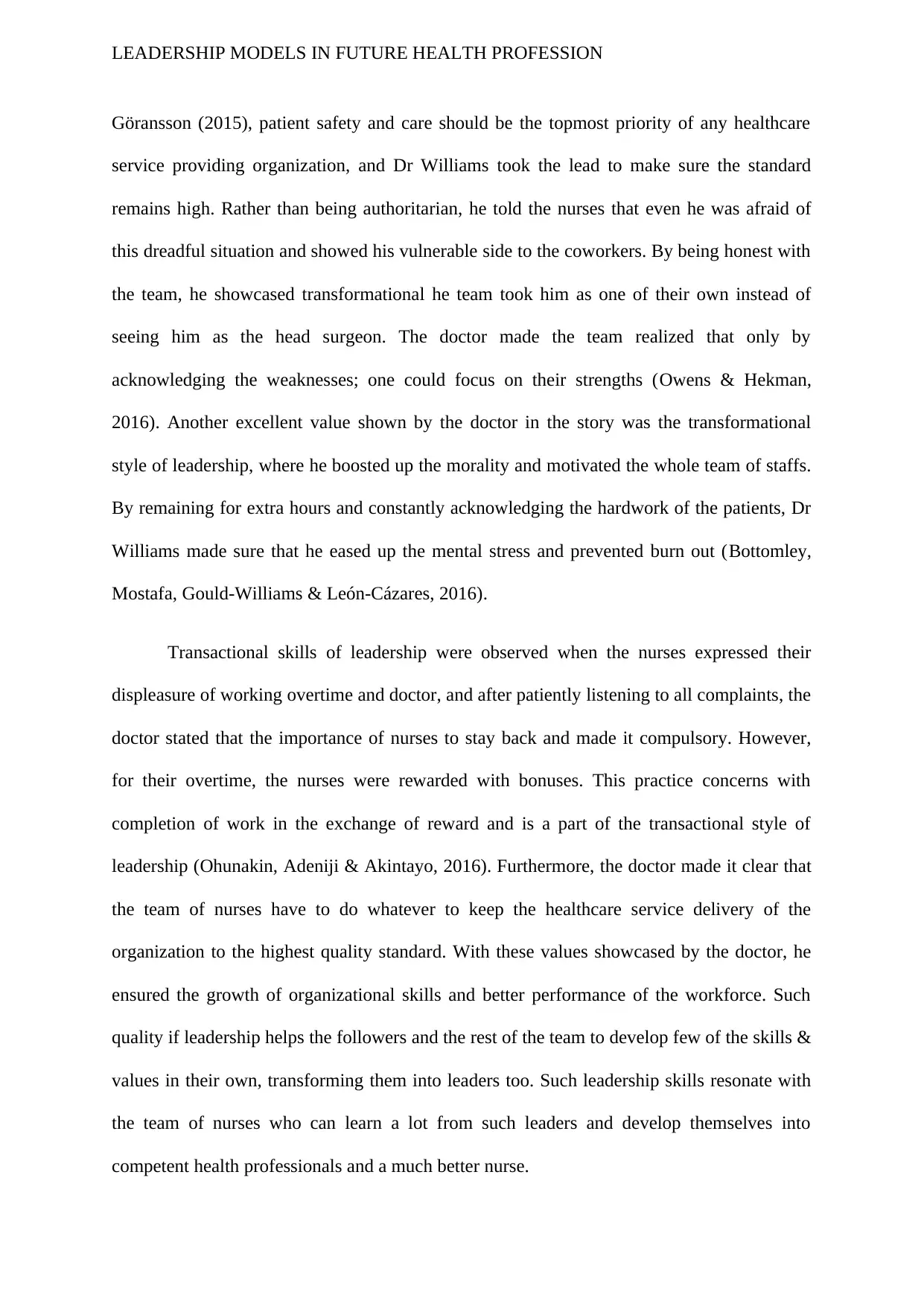
LEADERSHIP MODELS IN FUTURE HEALTH PROFESSION
Göransson (2015), patient safety and care should be the topmost priority of any healthcare
service providing organization, and Dr Williams took the lead to make sure the standard
remains high. Rather than being authoritarian, he told the nurses that even he was afraid of
this dreadful situation and showed his vulnerable side to the coworkers. By being honest with
the team, he showcased transformational he team took him as one of their own instead of
seeing him as the head surgeon. The doctor made the team realized that only by
acknowledging the weaknesses; one could focus on their strengths (Owens & Hekman,
2016). Another excellent value shown by the doctor in the story was the transformational
style of leadership, where he boosted up the morality and motivated the whole team of staffs.
By remaining for extra hours and constantly acknowledging the hardwork of the patients, Dr
Williams made sure that he eased up the mental stress and prevented burn out (Bottomley,
Mostafa, Gould‐Williams & León‐Cázares, 2016).
Transactional skills of leadership were observed when the nurses expressed their
displeasure of working overtime and doctor, and after patiently listening to all complaints, the
doctor stated that the importance of nurses to stay back and made it compulsory. However,
for their overtime, the nurses were rewarded with bonuses. This practice concerns with
completion of work in the exchange of reward and is a part of the transactional style of
leadership (Ohunakin, Adeniji & Akintayo, 2016). Furthermore, the doctor made it clear that
the team of nurses have to do whatever to keep the healthcare service delivery of the
organization to the highest quality standard. With these values showcased by the doctor, he
ensured the growth of organizational skills and better performance of the workforce. Such
quality if leadership helps the followers and the rest of the team to develop few of the skills &
values in their own, transforming them into leaders too. Such leadership skills resonate with
the team of nurses who can learn a lot from such leaders and develop themselves into
competent health professionals and a much better nurse.
Göransson (2015), patient safety and care should be the topmost priority of any healthcare
service providing organization, and Dr Williams took the lead to make sure the standard
remains high. Rather than being authoritarian, he told the nurses that even he was afraid of
this dreadful situation and showed his vulnerable side to the coworkers. By being honest with
the team, he showcased transformational he team took him as one of their own instead of
seeing him as the head surgeon. The doctor made the team realized that only by
acknowledging the weaknesses; one could focus on their strengths (Owens & Hekman,
2016). Another excellent value shown by the doctor in the story was the transformational
style of leadership, where he boosted up the morality and motivated the whole team of staffs.
By remaining for extra hours and constantly acknowledging the hardwork of the patients, Dr
Williams made sure that he eased up the mental stress and prevented burn out (Bottomley,
Mostafa, Gould‐Williams & León‐Cázares, 2016).
Transactional skills of leadership were observed when the nurses expressed their
displeasure of working overtime and doctor, and after patiently listening to all complaints, the
doctor stated that the importance of nurses to stay back and made it compulsory. However,
for their overtime, the nurses were rewarded with bonuses. This practice concerns with
completion of work in the exchange of reward and is a part of the transactional style of
leadership (Ohunakin, Adeniji & Akintayo, 2016). Furthermore, the doctor made it clear that
the team of nurses have to do whatever to keep the healthcare service delivery of the
organization to the highest quality standard. With these values showcased by the doctor, he
ensured the growth of organizational skills and better performance of the workforce. Such
quality if leadership helps the followers and the rest of the team to develop few of the skills &
values in their own, transforming them into leaders too. Such leadership skills resonate with
the team of nurses who can learn a lot from such leaders and develop themselves into
competent health professionals and a much better nurse.
Paraphrase This Document
Need a fresh take? Get an instant paraphrase of this document with our AI Paraphraser
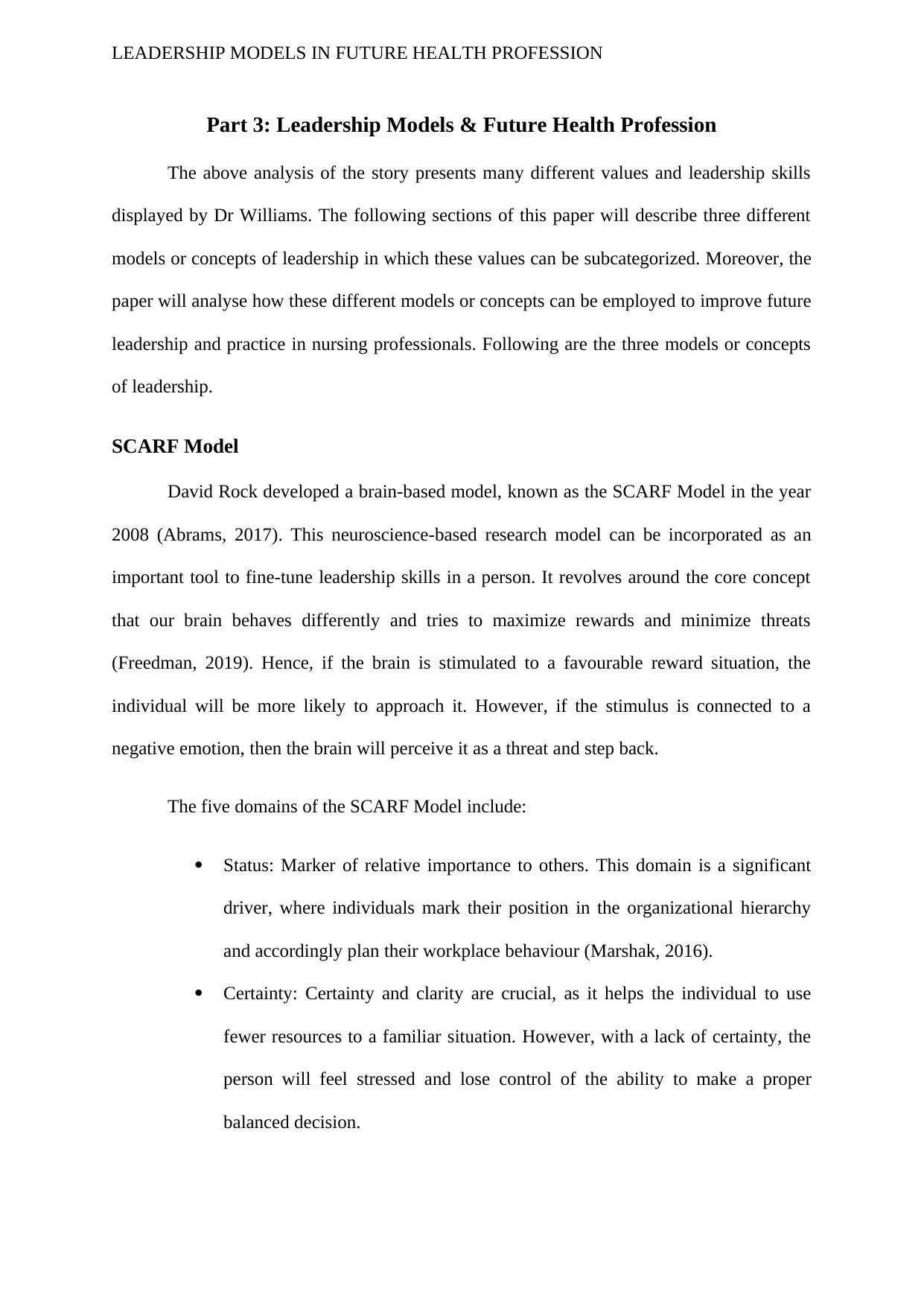
LEADERSHIP MODELS IN FUTURE HEALTH PROFESSION
Part 3: Leadership Models & Future Health Profession
The above analysis of the story presents many different values and leadership skills
displayed by Dr Williams. The following sections of this paper will describe three different
models or concepts of leadership in which these values can be subcategorized. Moreover, the
paper will analyse how these different models or concepts can be employed to improve future
leadership and practice in nursing professionals. Following are the three models or concepts
of leadership.
SCARF Model
David Rock developed a brain-based model, known as the SCARF Model in the year
2008 (Abrams, 2017). This neuroscience-based research model can be incorporated as an
important tool to fine-tune leadership skills in a person. It revolves around the core concept
that our brain behaves differently and tries to maximize rewards and minimize threats
(Freedman, 2019). Hence, if the brain is stimulated to a favourable reward situation, the
individual will be more likely to approach it. However, if the stimulus is connected to a
negative emotion, then the brain will perceive it as a threat and step back.
The five domains of the SCARF Model include:
Status: Marker of relative importance to others. This domain is a significant
driver, where individuals mark their position in the organizational hierarchy
and accordingly plan their workplace behaviour (Marshak, 2016).
Certainty: Certainty and clarity are crucial, as it helps the individual to use
fewer resources to a familiar situation. However, with a lack of certainty, the
person will feel stressed and lose control of the ability to make a proper
balanced decision.
Part 3: Leadership Models & Future Health Profession
The above analysis of the story presents many different values and leadership skills
displayed by Dr Williams. The following sections of this paper will describe three different
models or concepts of leadership in which these values can be subcategorized. Moreover, the
paper will analyse how these different models or concepts can be employed to improve future
leadership and practice in nursing professionals. Following are the three models or concepts
of leadership.
SCARF Model
David Rock developed a brain-based model, known as the SCARF Model in the year
2008 (Abrams, 2017). This neuroscience-based research model can be incorporated as an
important tool to fine-tune leadership skills in a person. It revolves around the core concept
that our brain behaves differently and tries to maximize rewards and minimize threats
(Freedman, 2019). Hence, if the brain is stimulated to a favourable reward situation, the
individual will be more likely to approach it. However, if the stimulus is connected to a
negative emotion, then the brain will perceive it as a threat and step back.
The five domains of the SCARF Model include:
Status: Marker of relative importance to others. This domain is a significant
driver, where individuals mark their position in the organizational hierarchy
and accordingly plan their workplace behaviour (Marshak, 2016).
Certainty: Certainty and clarity are crucial, as it helps the individual to use
fewer resources to a familiar situation. However, with a lack of certainty, the
person will feel stressed and lose control of the ability to make a proper
balanced decision.
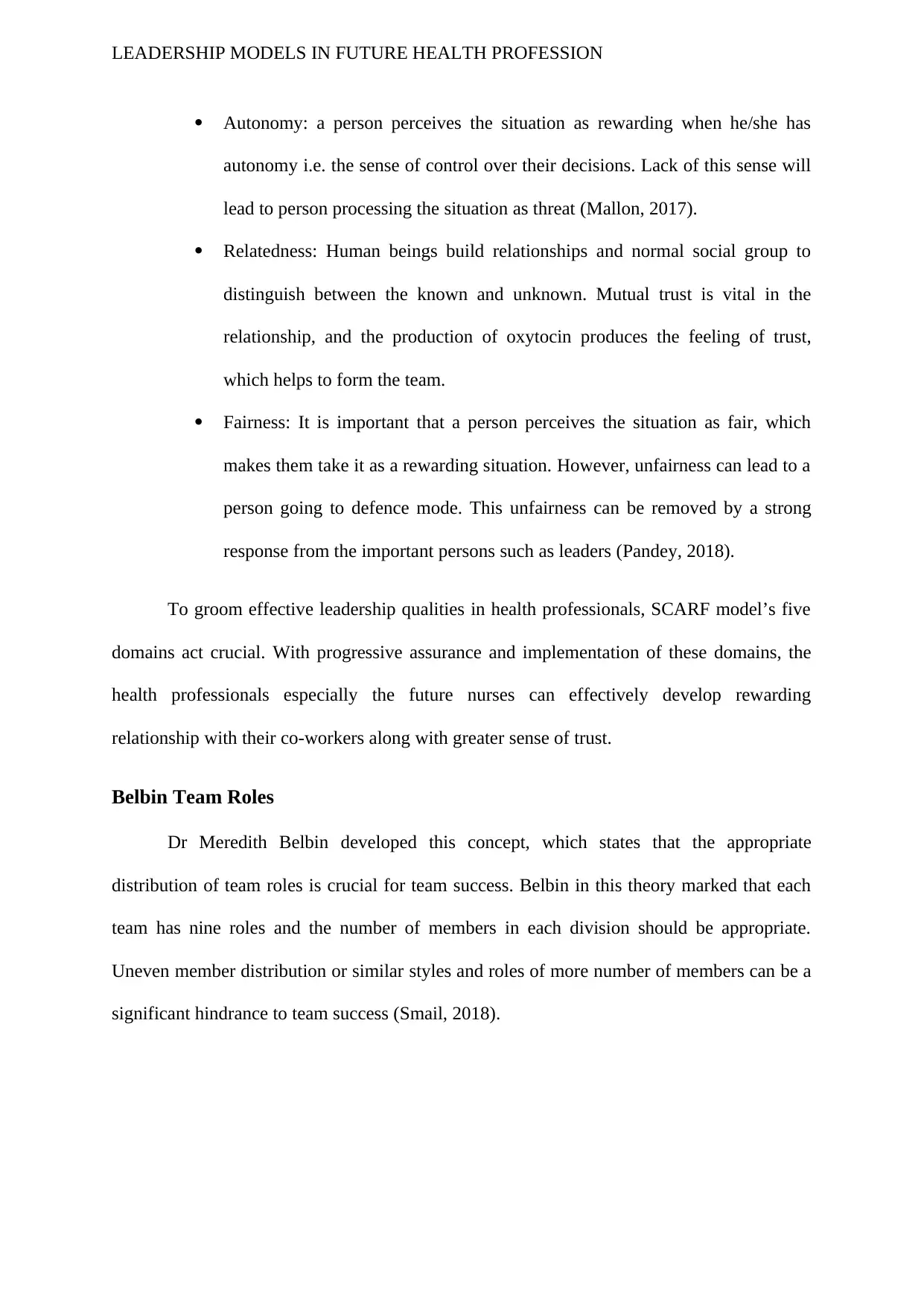
LEADERSHIP MODELS IN FUTURE HEALTH PROFESSION
Autonomy: a person perceives the situation as rewarding when he/she has
autonomy i.e. the sense of control over their decisions. Lack of this sense will
lead to person processing the situation as threat (Mallon, 2017).
Relatedness: Human beings build relationships and normal social group to
distinguish between the known and unknown. Mutual trust is vital in the
relationship, and the production of oxytocin produces the feeling of trust,
which helps to form the team.
Fairness: It is important that a person perceives the situation as fair, which
makes them take it as a rewarding situation. However, unfairness can lead to a
person going to defence mode. This unfairness can be removed by a strong
response from the important persons such as leaders (Pandey, 2018).
To groom effective leadership qualities in health professionals, SCARF model’s five
domains act crucial. With progressive assurance and implementation of these domains, the
health professionals especially the future nurses can effectively develop rewarding
relationship with their co-workers along with greater sense of trust.
Belbin Team Roles
Dr Meredith Belbin developed this concept, which states that the appropriate
distribution of team roles is crucial for team success. Belbin in this theory marked that each
team has nine roles and the number of members in each division should be appropriate.
Uneven member distribution or similar styles and roles of more number of members can be a
significant hindrance to team success (Smail, 2018).
Autonomy: a person perceives the situation as rewarding when he/she has
autonomy i.e. the sense of control over their decisions. Lack of this sense will
lead to person processing the situation as threat (Mallon, 2017).
Relatedness: Human beings build relationships and normal social group to
distinguish between the known and unknown. Mutual trust is vital in the
relationship, and the production of oxytocin produces the feeling of trust,
which helps to form the team.
Fairness: It is important that a person perceives the situation as fair, which
makes them take it as a rewarding situation. However, unfairness can lead to a
person going to defence mode. This unfairness can be removed by a strong
response from the important persons such as leaders (Pandey, 2018).
To groom effective leadership qualities in health professionals, SCARF model’s five
domains act crucial. With progressive assurance and implementation of these domains, the
health professionals especially the future nurses can effectively develop rewarding
relationship with their co-workers along with greater sense of trust.
Belbin Team Roles
Dr Meredith Belbin developed this concept, which states that the appropriate
distribution of team roles is crucial for team success. Belbin in this theory marked that each
team has nine roles and the number of members in each division should be appropriate.
Uneven member distribution or similar styles and roles of more number of members can be a
significant hindrance to team success (Smail, 2018).
⊘ This is a preview!⊘
Do you want full access?
Subscribe today to unlock all pages.

Trusted by 1+ million students worldwide
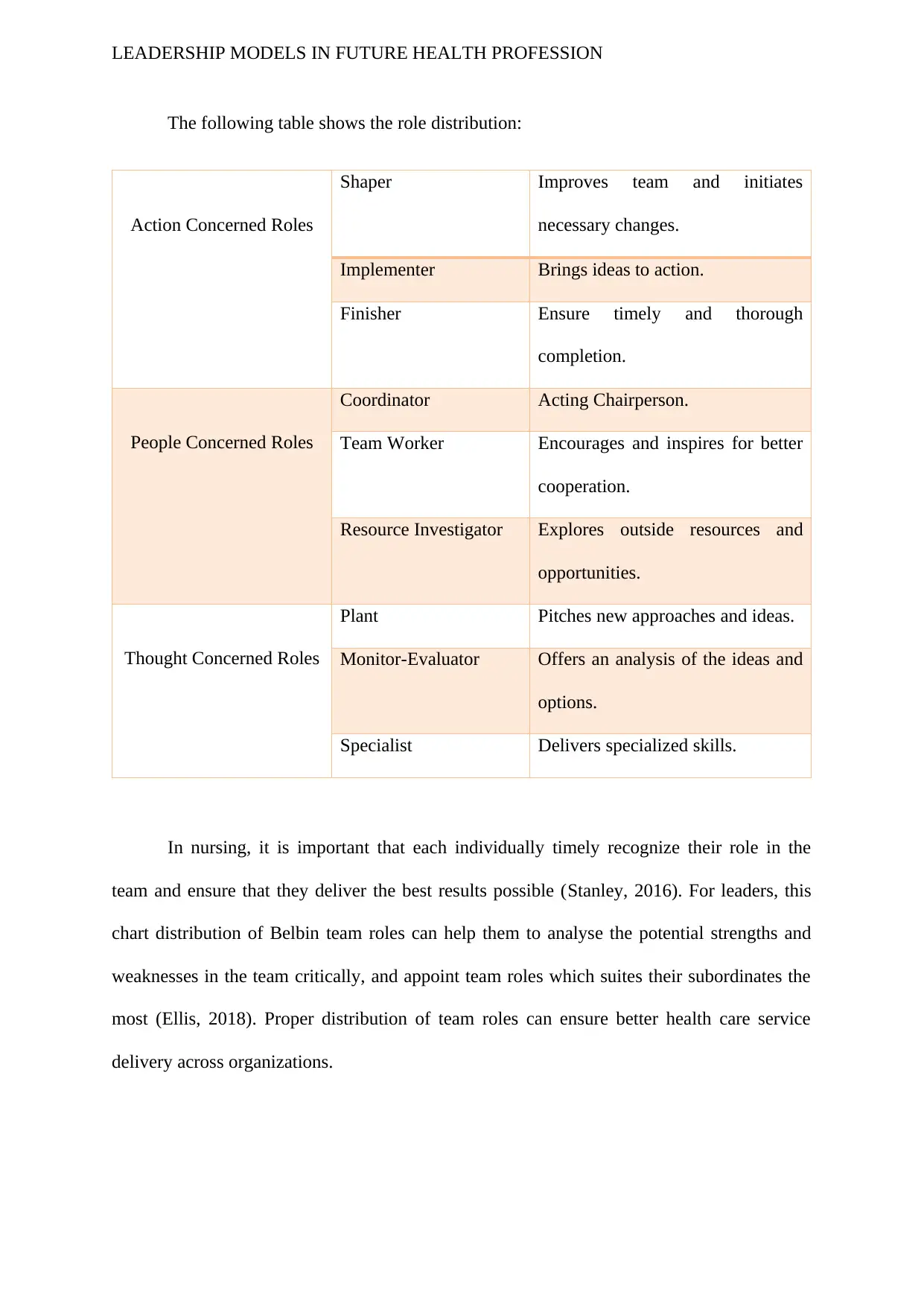
LEADERSHIP MODELS IN FUTURE HEALTH PROFESSION
The following table shows the role distribution:
Action Concerned Roles
Shaper Improves team and initiates
necessary changes.
Implementer Brings ideas to action.
Finisher Ensure timely and thorough
completion.
People Concerned Roles
Coordinator Acting Chairperson.
Team Worker Encourages and inspires for better
cooperation.
Resource Investigator Explores outside resources and
opportunities.
Thought Concerned Roles
Plant Pitches new approaches and ideas.
Monitor-Evaluator Offers an analysis of the ideas and
options.
Specialist Delivers specialized skills.
In nursing, it is important that each individually timely recognize their role in the
team and ensure that they deliver the best results possible (Stanley, 2016). For leaders, this
chart distribution of Belbin team roles can help them to analyse the potential strengths and
weaknesses in the team critically, and appoint team roles which suites their subordinates the
most (Ellis, 2018). Proper distribution of team roles can ensure better health care service
delivery across organizations.
The following table shows the role distribution:
Action Concerned Roles
Shaper Improves team and initiates
necessary changes.
Implementer Brings ideas to action.
Finisher Ensure timely and thorough
completion.
People Concerned Roles
Coordinator Acting Chairperson.
Team Worker Encourages and inspires for better
cooperation.
Resource Investigator Explores outside resources and
opportunities.
Thought Concerned Roles
Plant Pitches new approaches and ideas.
Monitor-Evaluator Offers an analysis of the ideas and
options.
Specialist Delivers specialized skills.
In nursing, it is important that each individually timely recognize their role in the
team and ensure that they deliver the best results possible (Stanley, 2016). For leaders, this
chart distribution of Belbin team roles can help them to analyse the potential strengths and
weaknesses in the team critically, and appoint team roles which suites their subordinates the
most (Ellis, 2018). Proper distribution of team roles can ensure better health care service
delivery across organizations.
Paraphrase This Document
Need a fresh take? Get an instant paraphrase of this document with our AI Paraphraser
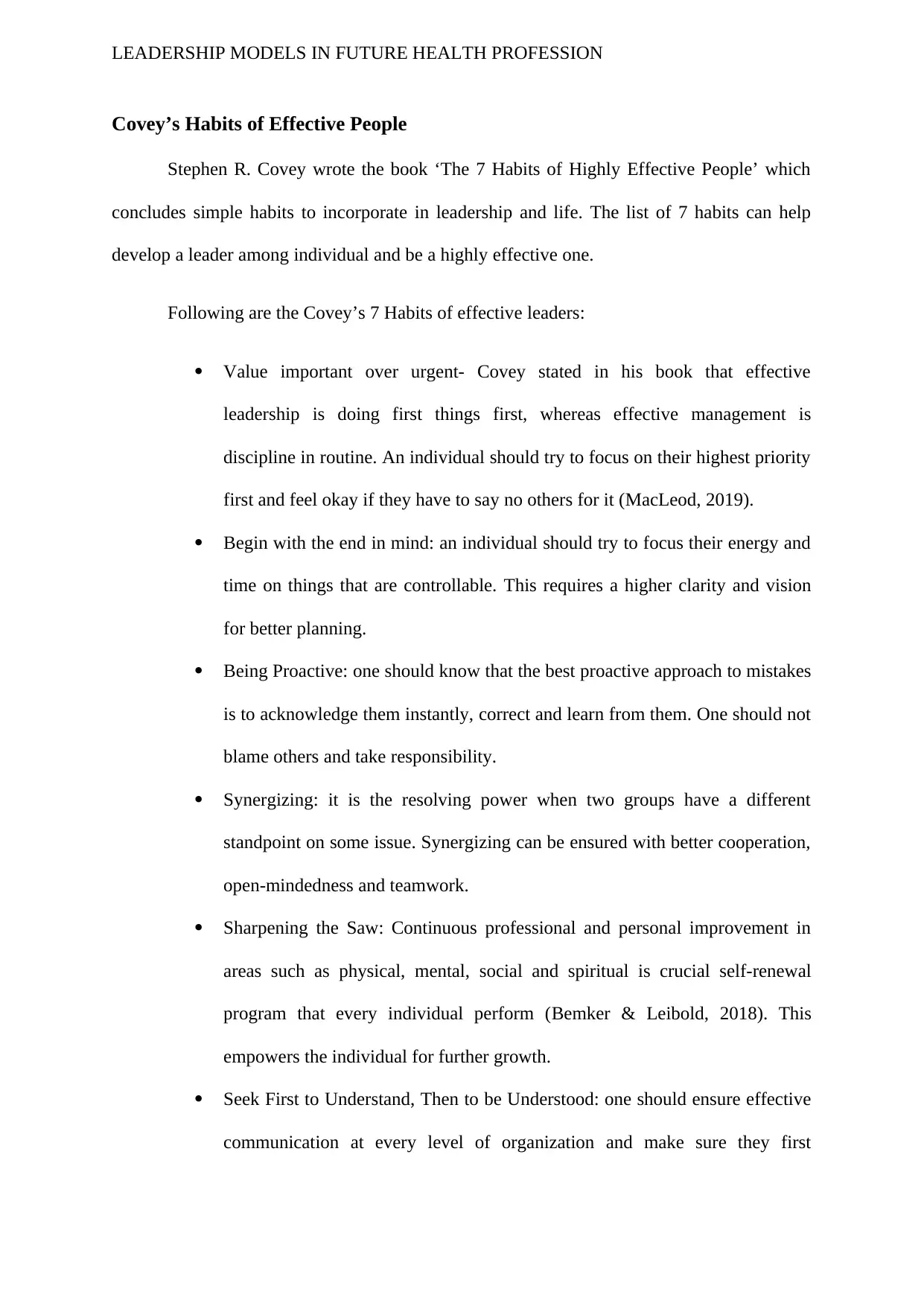
LEADERSHIP MODELS IN FUTURE HEALTH PROFESSION
Covey’s Habits of Effective People
Stephen R. Covey wrote the book ‘The 7 Habits of Highly Effective People’ which
concludes simple habits to incorporate in leadership and life. The list of 7 habits can help
develop a leader among individual and be a highly effective one.
Following are the Covey’s 7 Habits of effective leaders:
Value important over urgent- Covey stated in his book that effective
leadership is doing first things first, whereas effective management is
discipline in routine. An individual should try to focus on their highest priority
first and feel okay if they have to say no others for it (MacLeod, 2019).
Begin with the end in mind: an individual should try to focus their energy and
time on things that are controllable. This requires a higher clarity and vision
for better planning.
Being Proactive: one should know that the best proactive approach to mistakes
is to acknowledge them instantly, correct and learn from them. One should not
blame others and take responsibility.
Synergizing: it is the resolving power when two groups have a different
standpoint on some issue. Synergizing can be ensured with better cooperation,
open-mindedness and teamwork.
Sharpening the Saw: Continuous professional and personal improvement in
areas such as physical, mental, social and spiritual is crucial self-renewal
program that every individual perform (Bemker & Leibold, 2018). This
empowers the individual for further growth.
Seek First to Understand, Then to be Understood: one should ensure effective
communication at every level of organization and make sure they first
Covey’s Habits of Effective People
Stephen R. Covey wrote the book ‘The 7 Habits of Highly Effective People’ which
concludes simple habits to incorporate in leadership and life. The list of 7 habits can help
develop a leader among individual and be a highly effective one.
Following are the Covey’s 7 Habits of effective leaders:
Value important over urgent- Covey stated in his book that effective
leadership is doing first things first, whereas effective management is
discipline in routine. An individual should try to focus on their highest priority
first and feel okay if they have to say no others for it (MacLeod, 2019).
Begin with the end in mind: an individual should try to focus their energy and
time on things that are controllable. This requires a higher clarity and vision
for better planning.
Being Proactive: one should know that the best proactive approach to mistakes
is to acknowledge them instantly, correct and learn from them. One should not
blame others and take responsibility.
Synergizing: it is the resolving power when two groups have a different
standpoint on some issue. Synergizing can be ensured with better cooperation,
open-mindedness and teamwork.
Sharpening the Saw: Continuous professional and personal improvement in
areas such as physical, mental, social and spiritual is crucial self-renewal
program that every individual perform (Bemker & Leibold, 2018). This
empowers the individual for further growth.
Seek First to Understand, Then to be Understood: one should ensure effective
communication at every level of organization and make sure they first
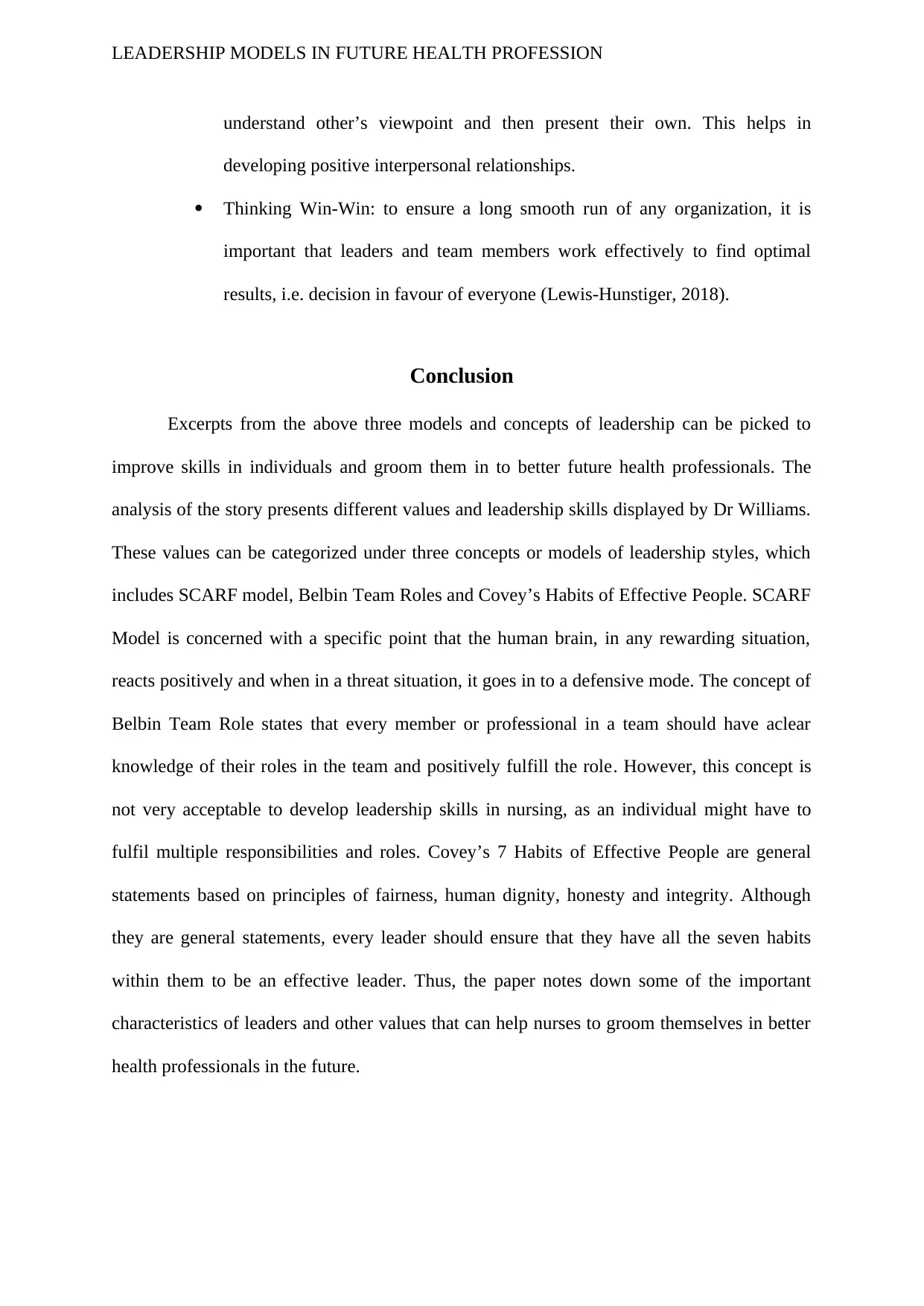
LEADERSHIP MODELS IN FUTURE HEALTH PROFESSION
understand other’s viewpoint and then present their own. This helps in
developing positive interpersonal relationships.
Thinking Win-Win: to ensure a long smooth run of any organization, it is
important that leaders and team members work effectively to find optimal
results, i.e. decision in favour of everyone (Lewis-Hunstiger, 2018).
Conclusion
Excerpts from the above three models and concepts of leadership can be picked to
improve skills in individuals and groom them in to better future health professionals. The
analysis of the story presents different values and leadership skills displayed by Dr Williams.
These values can be categorized under three concepts or models of leadership styles, which
includes SCARF model, Belbin Team Roles and Covey’s Habits of Effective People. SCARF
Model is concerned with a specific point that the human brain, in any rewarding situation,
reacts positively and when in a threat situation, it goes in to a defensive mode. The concept of
Belbin Team Role states that every member or professional in a team should have aclear
knowledge of their roles in the team and positively fulfill the role. However, this concept is
not very acceptable to develop leadership skills in nursing, as an individual might have to
fulfil multiple responsibilities and roles. Covey’s 7 Habits of Effective People are general
statements based on principles of fairness, human dignity, honesty and integrity. Although
they are general statements, every leader should ensure that they have all the seven habits
within them to be an effective leader. Thus, the paper notes down some of the important
characteristics of leaders and other values that can help nurses to groom themselves in better
health professionals in the future.
understand other’s viewpoint and then present their own. This helps in
developing positive interpersonal relationships.
Thinking Win-Win: to ensure a long smooth run of any organization, it is
important that leaders and team members work effectively to find optimal
results, i.e. decision in favour of everyone (Lewis-Hunstiger, 2018).
Conclusion
Excerpts from the above three models and concepts of leadership can be picked to
improve skills in individuals and groom them in to better future health professionals. The
analysis of the story presents different values and leadership skills displayed by Dr Williams.
These values can be categorized under three concepts or models of leadership styles, which
includes SCARF model, Belbin Team Roles and Covey’s Habits of Effective People. SCARF
Model is concerned with a specific point that the human brain, in any rewarding situation,
reacts positively and when in a threat situation, it goes in to a defensive mode. The concept of
Belbin Team Role states that every member or professional in a team should have aclear
knowledge of their roles in the team and positively fulfill the role. However, this concept is
not very acceptable to develop leadership skills in nursing, as an individual might have to
fulfil multiple responsibilities and roles. Covey’s 7 Habits of Effective People are general
statements based on principles of fairness, human dignity, honesty and integrity. Although
they are general statements, every leader should ensure that they have all the seven habits
within them to be an effective leader. Thus, the paper notes down some of the important
characteristics of leaders and other values that can help nurses to groom themselves in better
health professionals in the future.
⊘ This is a preview!⊘
Do you want full access?
Subscribe today to unlock all pages.

Trusted by 1+ million students worldwide
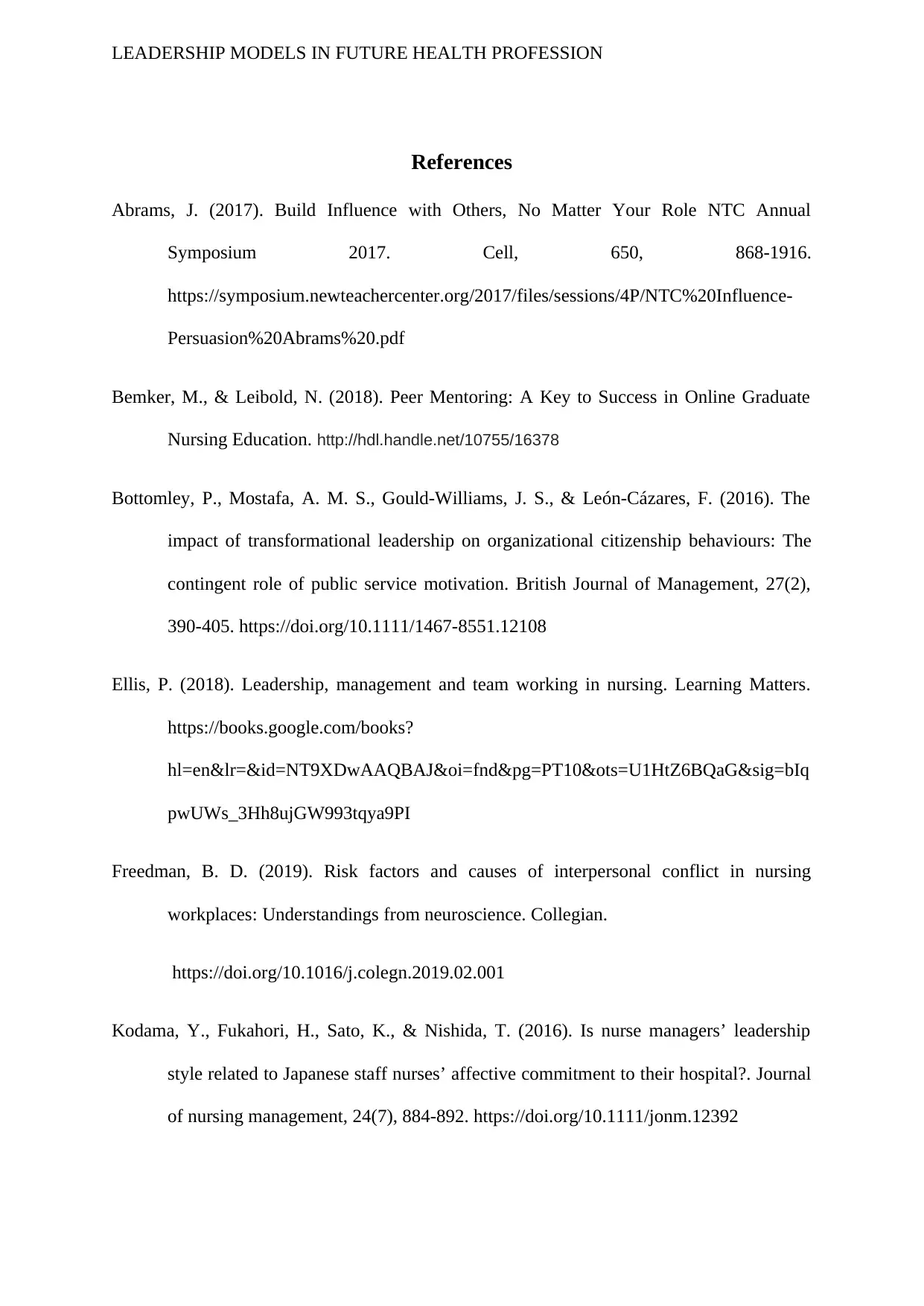
LEADERSHIP MODELS IN FUTURE HEALTH PROFESSION
References
Abrams, J. (2017). Build Influence with Others, No Matter Your Role NTC Annual
Symposium 2017. Cell, 650, 868-1916.
https://symposium.newteachercenter.org/2017/files/sessions/4P/NTC%20Influence-
Persuasion%20Abrams%20.pdf
Bemker, M., & Leibold, N. (2018). Peer Mentoring: A Key to Success in Online Graduate
Nursing Education. http://hdl.handle.net/10755/16378
Bottomley, P., Mostafa, A. M. S., Gould‐Williams, J. S., & León‐Cázares, F. (2016). The
impact of transformational leadership on organizational citizenship behaviours: The
contingent role of public service motivation. British Journal of Management, 27(2),
390-405. https://doi.org/10.1111/1467-8551.12108
Ellis, P. (2018). Leadership, management and team working in nursing. Learning Matters.
https://books.google.com/books?
hl=en&lr=&id=NT9XDwAAQBAJ&oi=fnd&pg=PT10&ots=U1HtZ6BQaG&sig=bIq
pwUWs_3Hh8ujGW993tqya9PI
Freedman, B. D. (2019). Risk factors and causes of interpersonal conflict in nursing
workplaces: Understandings from neuroscience. Collegian.
https://doi.org/10.1016/j.colegn.2019.02.001
Kodama, Y., Fukahori, H., Sato, K., & Nishida, T. (2016). Is nurse managers’ leadership
style related to Japanese staff nurses’ affective commitment to their hospital?. Journal
of nursing management, 24(7), 884-892. https://doi.org/10.1111/jonm.12392
References
Abrams, J. (2017). Build Influence with Others, No Matter Your Role NTC Annual
Symposium 2017. Cell, 650, 868-1916.
https://symposium.newteachercenter.org/2017/files/sessions/4P/NTC%20Influence-
Persuasion%20Abrams%20.pdf
Bemker, M., & Leibold, N. (2018). Peer Mentoring: A Key to Success in Online Graduate
Nursing Education. http://hdl.handle.net/10755/16378
Bottomley, P., Mostafa, A. M. S., Gould‐Williams, J. S., & León‐Cázares, F. (2016). The
impact of transformational leadership on organizational citizenship behaviours: The
contingent role of public service motivation. British Journal of Management, 27(2),
390-405. https://doi.org/10.1111/1467-8551.12108
Ellis, P. (2018). Leadership, management and team working in nursing. Learning Matters.
https://books.google.com/books?
hl=en&lr=&id=NT9XDwAAQBAJ&oi=fnd&pg=PT10&ots=U1HtZ6BQaG&sig=bIq
pwUWs_3Hh8ujGW993tqya9PI
Freedman, B. D. (2019). Risk factors and causes of interpersonal conflict in nursing
workplaces: Understandings from neuroscience. Collegian.
https://doi.org/10.1016/j.colegn.2019.02.001
Kodama, Y., Fukahori, H., Sato, K., & Nishida, T. (2016). Is nurse managers’ leadership
style related to Japanese staff nurses’ affective commitment to their hospital?. Journal
of nursing management, 24(7), 884-892. https://doi.org/10.1111/jonm.12392
Paraphrase This Document
Need a fresh take? Get an instant paraphrase of this document with our AI Paraphraser
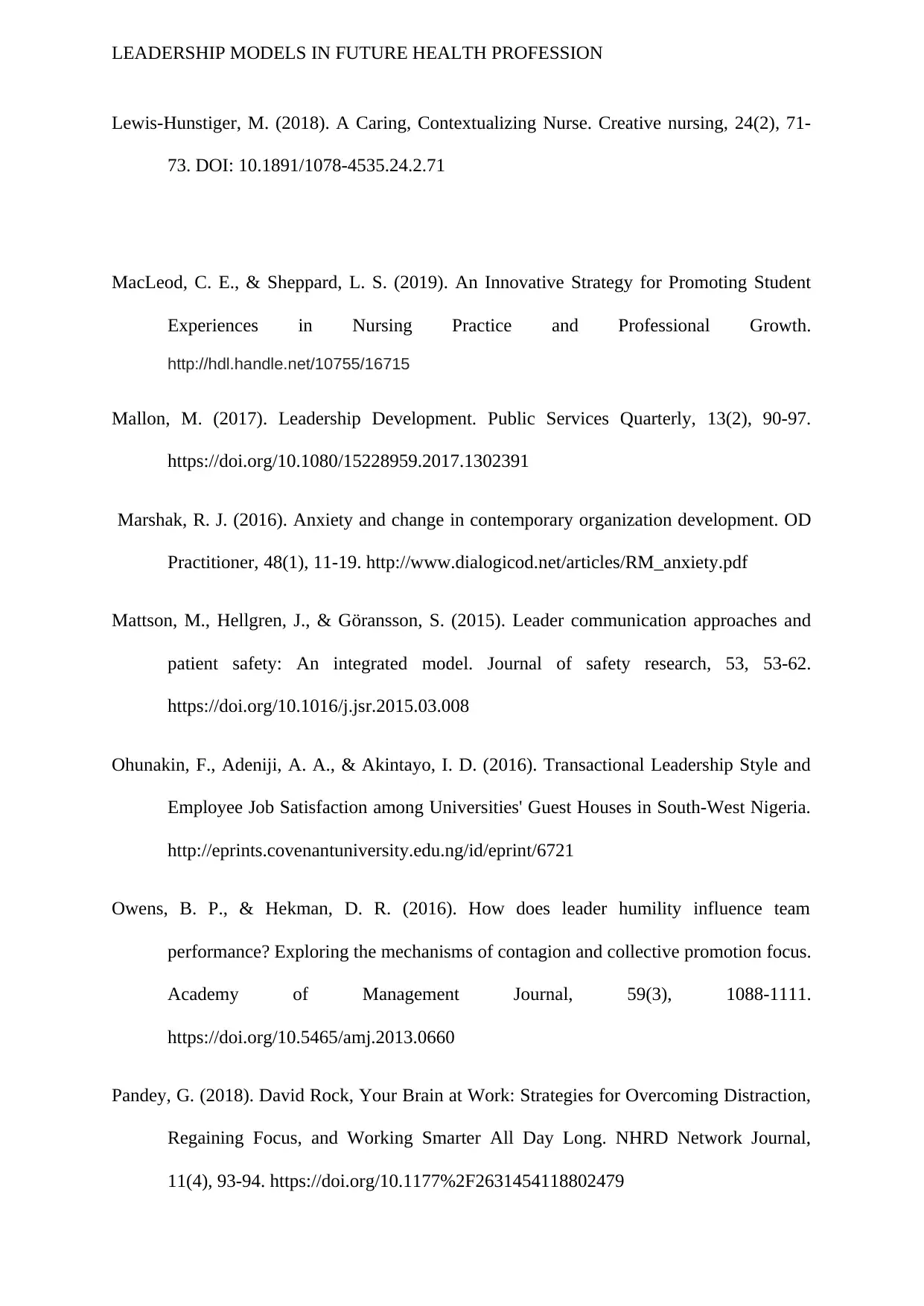
LEADERSHIP MODELS IN FUTURE HEALTH PROFESSION
Lewis-Hunstiger, M. (2018). A Caring, Contextualizing Nurse. Creative nursing, 24(2), 71-
73. DOI: 10.1891/1078-4535.24.2.71
MacLeod, C. E., & Sheppard, L. S. (2019). An Innovative Strategy for Promoting Student
Experiences in Nursing Practice and Professional Growth.
http://hdl.handle.net/10755/16715
Mallon, M. (2017). Leadership Development. Public Services Quarterly, 13(2), 90-97.
https://doi.org/10.1080/15228959.2017.1302391
Marshak, R. J. (2016). Anxiety and change in contemporary organization development. OD
Practitioner, 48(1), 11-19. http://www.dialogicod.net/articles/RM_anxiety.pdf
Mattson, M., Hellgren, J., & Göransson, S. (2015). Leader communication approaches and
patient safety: An integrated model. Journal of safety research, 53, 53-62.
https://doi.org/10.1016/j.jsr.2015.03.008
Ohunakin, F., Adeniji, A. A., & Akintayo, I. D. (2016). Transactional Leadership Style and
Employee Job Satisfaction among Universities' Guest Houses in South-West Nigeria.
http://eprints.covenantuniversity.edu.ng/id/eprint/6721
Owens, B. P., & Hekman, D. R. (2016). How does leader humility influence team
performance? Exploring the mechanisms of contagion and collective promotion focus.
Academy of Management Journal, 59(3), 1088-1111.
https://doi.org/10.5465/amj.2013.0660
Pandey, G. (2018). David Rock, Your Brain at Work: Strategies for Overcoming Distraction,
Regaining Focus, and Working Smarter All Day Long. NHRD Network Journal,
11(4), 93-94. https://doi.org/10.1177%2F2631454118802479
Lewis-Hunstiger, M. (2018). A Caring, Contextualizing Nurse. Creative nursing, 24(2), 71-
73. DOI: 10.1891/1078-4535.24.2.71
MacLeod, C. E., & Sheppard, L. S. (2019). An Innovative Strategy for Promoting Student
Experiences in Nursing Practice and Professional Growth.
http://hdl.handle.net/10755/16715
Mallon, M. (2017). Leadership Development. Public Services Quarterly, 13(2), 90-97.
https://doi.org/10.1080/15228959.2017.1302391
Marshak, R. J. (2016). Anxiety and change in contemporary organization development. OD
Practitioner, 48(1), 11-19. http://www.dialogicod.net/articles/RM_anxiety.pdf
Mattson, M., Hellgren, J., & Göransson, S. (2015). Leader communication approaches and
patient safety: An integrated model. Journal of safety research, 53, 53-62.
https://doi.org/10.1016/j.jsr.2015.03.008
Ohunakin, F., Adeniji, A. A., & Akintayo, I. D. (2016). Transactional Leadership Style and
Employee Job Satisfaction among Universities' Guest Houses in South-West Nigeria.
http://eprints.covenantuniversity.edu.ng/id/eprint/6721
Owens, B. P., & Hekman, D. R. (2016). How does leader humility influence team
performance? Exploring the mechanisms of contagion and collective promotion focus.
Academy of Management Journal, 59(3), 1088-1111.
https://doi.org/10.5465/amj.2013.0660
Pandey, G. (2018). David Rock, Your Brain at Work: Strategies for Overcoming Distraction,
Regaining Focus, and Working Smarter All Day Long. NHRD Network Journal,
11(4), 93-94. https://doi.org/10.1177%2F2631454118802479
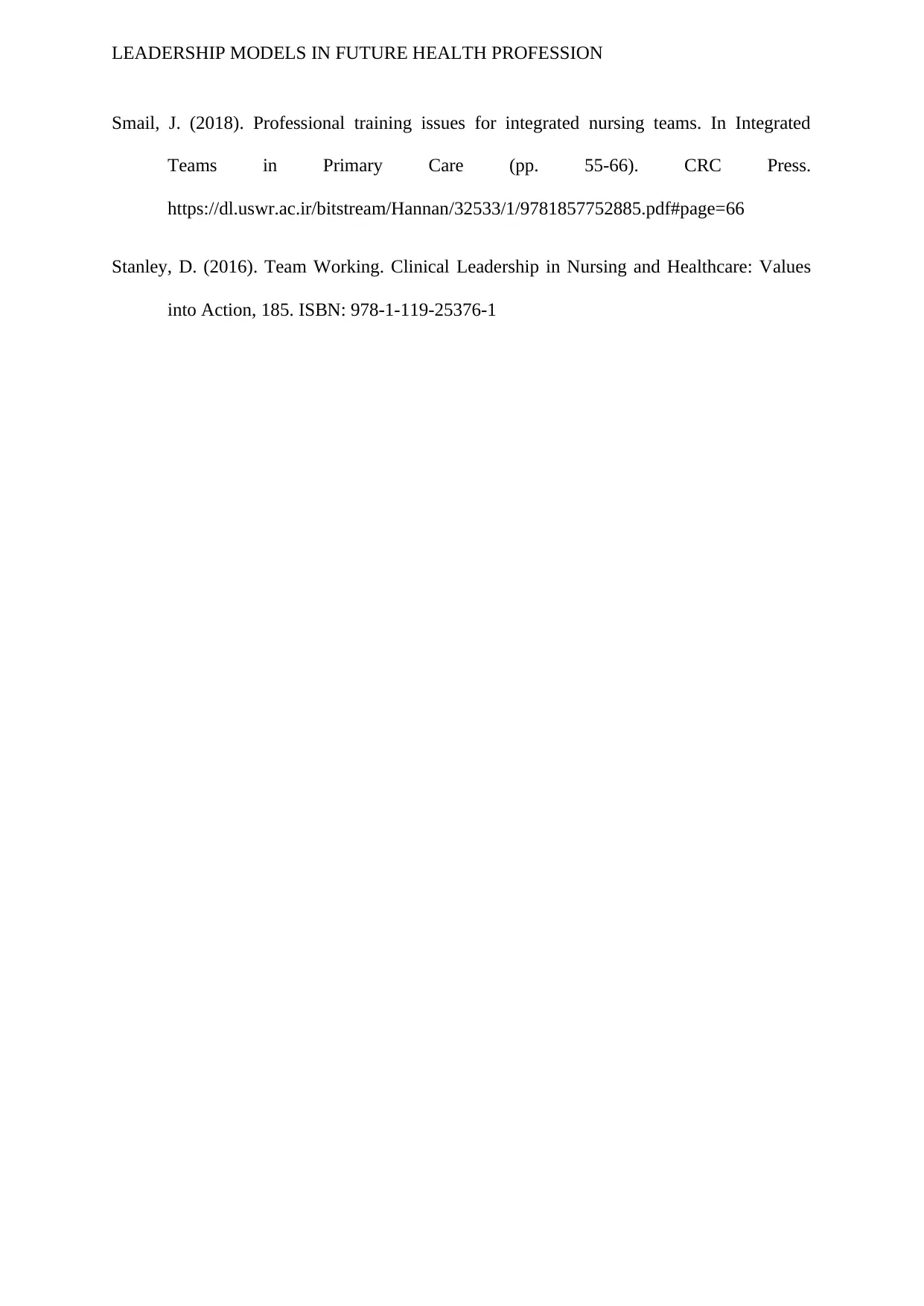
LEADERSHIP MODELS IN FUTURE HEALTH PROFESSION
Smail, J. (2018). Professional training issues for integrated nursing teams. In Integrated
Teams in Primary Care (pp. 55-66). CRC Press.
https://dl.uswr.ac.ir/bitstream/Hannan/32533/1/9781857752885.pdf#page=66
Stanley, D. (2016). Team Working. Clinical Leadership in Nursing and Healthcare: Values
into Action, 185. ISBN: 978-1-119-25376-1
Smail, J. (2018). Professional training issues for integrated nursing teams. In Integrated
Teams in Primary Care (pp. 55-66). CRC Press.
https://dl.uswr.ac.ir/bitstream/Hannan/32533/1/9781857752885.pdf#page=66
Stanley, D. (2016). Team Working. Clinical Leadership in Nursing and Healthcare: Values
into Action, 185. ISBN: 978-1-119-25376-1
⊘ This is a preview!⊘
Do you want full access?
Subscribe today to unlock all pages.

Trusted by 1+ million students worldwide
1 out of 12
Related Documents
Your All-in-One AI-Powered Toolkit for Academic Success.
+13062052269
info@desklib.com
Available 24*7 on WhatsApp / Email
![[object Object]](/_next/static/media/star-bottom.7253800d.svg)
Unlock your academic potential
Copyright © 2020–2025 A2Z Services. All Rights Reserved. Developed and managed by ZUCOL.





